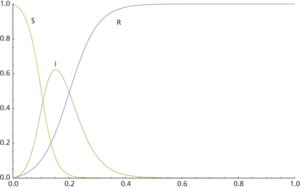In an SIR epidemiology model, there are three mutually exclusive subsets of a constant population as a disease spreads: the fractions of the population that are susceptible S, infected I, and recovered R. A first such model was due to Kermack and McKendrick in 1927. The equations governing the model are
where α is a positive constant relating to how contagious the disease is and the level of contact between people and β is a positive constant relating to the rate of recovery. If cases grow, then the maximum value of I is an increasing function of R0 = α/β, which is the expected number of people an infected person infects.
Such an SIR model makes accurate predictions for a disease spreading through a homogeneous closed population, but clearly the model does not take into account different demographics within a population, movement of people, mutation of the disease, catching the disease more than once, and responses from governments and society. There are many other so-called ‘compartmental models’ addressing some of these aspects.

Graphs of S, I, and R in an epidemiology model
- STG
- sthenic
- stibnite
- stickleback
- stick-slip
- sticky
- sticky content
- sticky end
- sticky prices
- sticky spot
- sticky wages
- stiff equations
- stiffness
- stigma
- Stigmaria
- still
- Stille, Wilhelm Hans (1876–1976)
- still gas
- Stillingfleet, Edward (1635–99)
- Still-Kilrain, Susan (1961– )
- stillstand
- stilpnomelane
- stilt root
- Stilwell, Joseph Warren (1883–1946)
- Stimson, Henry Lewis (1867–1950)